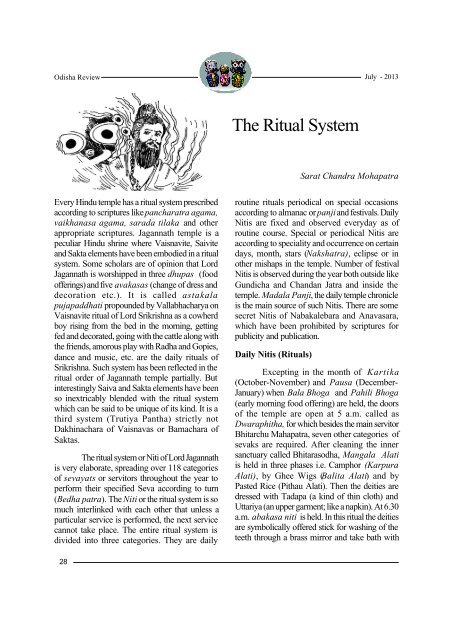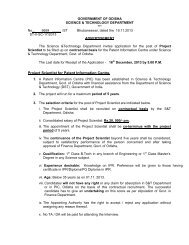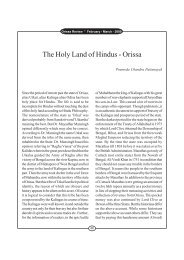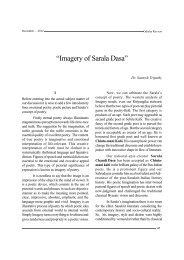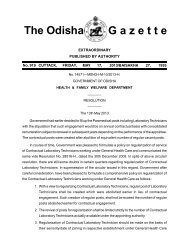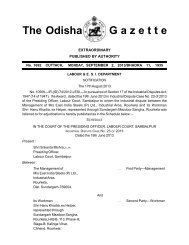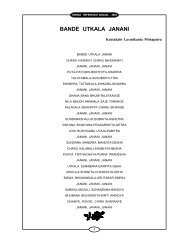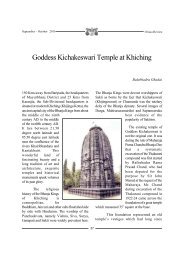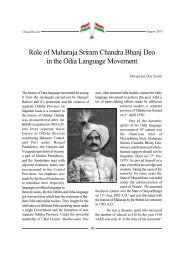The Ritual System - Odisha.gov.in
The Ritual System - Odisha.gov.in
The Ritual System - Odisha.gov.in
You also want an ePaper? Increase the reach of your titles
YUMPU automatically turns print PDFs into web optimized ePapers that Google loves.
<strong>Odisha</strong> Review July - 2013<br />
<strong>The</strong> <strong>Ritual</strong> <strong>System</strong><br />
Sarat Chandra Mohapatra<br />
Every H<strong>in</strong>du temple has a ritual system prescribed<br />
accord<strong>in</strong>g to scriptures like pancharatra agama,<br />
vaikhanasa agama, sarada tilaka and other<br />
appropriate scriptures. Jagannath temple is a<br />
peculiar H<strong>in</strong>du shr<strong>in</strong>e where Vaisnavite, Saivite<br />
and Sakta elements have been embodied <strong>in</strong> a ritual<br />
system. Some scholars are of op<strong>in</strong>ion that Lord<br />
Jagannath is worshipped <strong>in</strong> three dhupas (food<br />
offer<strong>in</strong>gs) and five avakasas (change of dress and<br />
decoration etc.). It is called astakala<br />
pujapaddhati propounded by Vallabhacharya on<br />
Vaisnavite ritual of Lord Srikrishna as a cowherd<br />
boy ris<strong>in</strong>g from the bed <strong>in</strong> the morn<strong>in</strong>g, gett<strong>in</strong>g<br />
fed and decorated, go<strong>in</strong>g with the cattle along with<br />
the friends, amorous play with Radha and Gopies,<br />
dance and music, etc. are the daily rituals of<br />
Srikrishna. Such system has been reflected <strong>in</strong> the<br />
ritual order of Jagannath temple partially. But<br />
<strong>in</strong>terest<strong>in</strong>gly Saiva and Sakta elements have been<br />
so <strong>in</strong>extricably blended with the ritual system<br />
which can be said to be unique of its k<strong>in</strong>d. It is a<br />
third system (Trutiya Pantha) strictly not<br />
Dakh<strong>in</strong>achara of Vaisnavas or Bamachara of<br />
Saktas.<br />
<strong>The</strong> ritual system or Niti of Lord Jagannath<br />
is very elaborate, spread<strong>in</strong>g over 118 categories<br />
of sevayats or servitors throughout the year to<br />
perform their specified Seva accord<strong>in</strong>g to turn<br />
(Bedha patra). <strong>The</strong> Niti or the ritual system is so<br />
much <strong>in</strong>terl<strong>in</strong>ked with each other that unless a<br />
particular service is performed, the next service<br />
cannot take place. <strong>The</strong> entire ritual system is<br />
divided <strong>in</strong>to three categories. <strong>The</strong>y are daily<br />
rout<strong>in</strong>e rituals periodical on special occasions<br />
accord<strong>in</strong>g to almanac or panji and festivals. Daily<br />
Nitis are fixed and observed everyday as of<br />
rout<strong>in</strong>e course. Special or periodical Nitis are<br />
accord<strong>in</strong>g to speciality and occurrence on certa<strong>in</strong><br />
days, month, stars (Nakshatra), eclipse or <strong>in</strong><br />
other mishaps <strong>in</strong> the temple. Number of festival<br />
Nitis is observed dur<strong>in</strong>g the year both outside like<br />
Gundicha and Chandan Jatra and <strong>in</strong>side the<br />
temple. Madala Panji, the daily temple chronicle<br />
is the ma<strong>in</strong> source of such Nitis. <strong>The</strong>re are some<br />
secret Nitis of Nabakalebara and Anavasara,<br />
which have been prohibited by scriptures for<br />
publicity and publication.<br />
Daily Nitis (<strong>Ritual</strong>s)<br />
Except<strong>in</strong>g <strong>in</strong> the month of Kartika<br />
(October-November) and Pausa (December-<br />
January) when Bala Bhoga and Pahili Bhoga<br />
(early morn<strong>in</strong>g food offer<strong>in</strong>g) are held, the doors<br />
of the temple are open at 5 a.m. called as<br />
Dwaraphitha, for which besides the ma<strong>in</strong> servitor<br />
Bhitarchu Mahapatra, seven other categories of<br />
sevaks are required. After clean<strong>in</strong>g the <strong>in</strong>ner<br />
sanctuary called Bhitarasodha, Mangala Alati<br />
is held <strong>in</strong> three phases i.e. Camphor (Karpura<br />
Alati), by Ghee Wigs (Balita Alati) and by<br />
Pasted Rice (Pithau Alati). <strong>The</strong>n the deities are<br />
dressed with Tadapa (a k<strong>in</strong>d of th<strong>in</strong> cloth) and<br />
Uttariya (an upper garment; like a napk<strong>in</strong>). At 6.30<br />
a.m. abakasa niti is held. In this ritual the deities<br />
are symbolically offered stick for wash<strong>in</strong>g of the<br />
teeth through a brass mirror and take bath with<br />
28
July - 2013<br />
curd etc. over the mirrors placed <strong>in</strong> front of the<br />
deities. After abakasa the deities are adorned<br />
with silken cloths, flowers and ornaments, after<br />
which Sahana Mela or Sarva Sadharana<br />
Darshan (free entry of pilgrims to the <strong>in</strong>ner<br />
sanctuary) takes place. It provides an opportunity<br />
to devotees and pilgrims to go near the Ratna<br />
S<strong>in</strong>ghasana to have a closer view of the deities<br />
and circumbulation (pradakh<strong>in</strong>a) of the<br />
Ratnas<strong>in</strong>ghasana. If dur<strong>in</strong>g this time any person<br />
touches the holy bodies, spits, passes stool or<br />
ur<strong>in</strong>e or vomits, then the deities are given a<br />
purificatory bath called Mahasnana. <strong>The</strong>re is<br />
provision for penalty on the person for do<strong>in</strong>g so.<br />
Usually children of tender age are not allowed to<br />
go <strong>in</strong>side. From 8 a.m. to 8.30 a.m. the deities<br />
are dressed <strong>in</strong> different coloured dresses<br />
prescribed for different seasons and occasions.<br />
Simultaneously <strong>in</strong> the meantime roso<br />
homo or putt<strong>in</strong>g sacred fire <strong>in</strong> the kitchen, Surya<br />
Puja (Worship of the Sun God) and Dwarapala<br />
Puja (worship of the door guard<strong>in</strong>g deities – Jaya<br />
and Vijaya) are held. <strong>The</strong>n the breakfast is offered<br />
to the Lords called Gopal Ballava Bhoga. It<br />
consists of sweets, fruits, curd, butter, green<br />
coconut, sweetened coconut balls (laddu),<br />
planta<strong>in</strong>s, Khua Manda (cream ball) and Ballava<br />
Khai (twice fried rice mixed with ghee and sugar)<br />
etc.<br />
<strong>The</strong> next cooked food offer<strong>in</strong>g to the<br />
Lords is known as Sakala Dhupa or Raja<br />
Bhoga. Besides the rice of different varieties, the<br />
cakes of black gram (biri) and other prescribed<br />
items are served <strong>in</strong> limited quantities and number.<br />
<strong>The</strong>n the deities change their dresses, decorated<br />
and take the next food offer<strong>in</strong>g called Bhoga<br />
Mandapa <strong>in</strong> the refractory hall beh<strong>in</strong>d Garuda<br />
stambha. This Bhoga or food offer<strong>in</strong>g has been<br />
<strong>in</strong>troduced to cater Mahaprasad to the pilgrims,<br />
various Matha and other <strong>in</strong>stitutions, private<br />
<strong>in</strong>dividuals <strong>in</strong> huge quantities. This is ma<strong>in</strong>ly meant<br />
for sale.<br />
<strong>Odisha</strong> Review<br />
Madhyanha Dhupa or pr<strong>in</strong>cipal mid day<br />
Bhoga is offered at 1 p.m. <strong>in</strong> which different types<br />
of rice, pulses, vegetables and variety of cakes<br />
are offered. District Gazetteer (Pp.809) records<br />
that 435 food items were offered <strong>in</strong> this dhupa <strong>in</strong><br />
1910. It consists of rice of various k<strong>in</strong>ds, pulses<br />
and vegetables with varieties of cakes and sweets.<br />
<strong>The</strong>n the deities retire for a mid-day siesta (diba<br />
pahuda) after be<strong>in</strong>g offered green coconut,<br />
perfumed water and beetle nut. <strong>The</strong>y get up at 6<br />
p.m. when Sandhya Alati or even<strong>in</strong>g offer<strong>in</strong>g of<br />
sacred lamp <strong>in</strong> camphor, ghee wigs and pasted<br />
rice is done. <strong>The</strong> devotees and pilgrims eagerly<br />
stand await<strong>in</strong>g to see this ritual.<br />
At 8 p.m. Sandhya Dhupa or night food<br />
offer<strong>in</strong>g is served which consists of ghee rice<br />
(gheeanna) and fragrant sweetened soaked rice<br />
(subasa pakhala), sweets, cakes of black gram,<br />
etc. <strong>The</strong>n at 9.15 p.m. the Gods appear for public<br />
Darshan. <strong>The</strong> Gods then change dresses after<br />
be<strong>in</strong>g smeared with fragrant sandal paste mixed<br />
with Karpura (camphor), Keshar and Kasturi<br />
<strong>in</strong> silver pots called Chandan Lagi. At 10.30<br />
p.m. the deities aga<strong>in</strong> change their dresses and<br />
wear Baralagi Pata (the silken cloth with<br />
prescribed colour of the day). <strong>The</strong> Lords are then<br />
decorated with flower decoratives called<br />
Chandrika on head, Nakachana on nose,<br />
Karapallava on hands and padaka on the chest<br />
along with lots of other flower garlands. Some<br />
selected stanzas of Gita Gov<strong>in</strong>da, composed by<br />
Odia poet Jayadev are woven on the body of the<br />
saree called Gita Gov<strong>in</strong>da khandua, which the<br />
Lords put on dur<strong>in</strong>g this ritual. After that Bada<br />
S<strong>in</strong>ghara Dhupa or last food offer<strong>in</strong>g takes<br />
place. A particular cake prepared by green banana<br />
called Kadali Bada, pitha of black gram, khiri<br />
(milk made sweetened item), kanji (a curd<br />
preparation), soaked rice, etc are offered <strong>in</strong> this<br />
Dhupa. <strong>The</strong> last rite is at 12 p.m. when the musical<br />
<strong>in</strong>struments like veena and drum are played with<br />
Gita Gov<strong>in</strong>da music, dance by Mahari or<br />
29
<strong>Odisha</strong> Review July - 2013<br />
Debadasi, puspanjali (offer<strong>in</strong>g of flower) is held.<br />
<strong>The</strong> golden cots are brought <strong>in</strong>side and the<br />
Sayana Thakura or the sleep<strong>in</strong>g deities<br />
(Ardhanariswara – a composite figure of Lord<br />
Vishnu and Laxmi) are brought to Jaya-Vijya<br />
Dwara (entrance door to the <strong>in</strong>ner sanctuary)<br />
where green coconut, fragrant water (ghasa jala)<br />
and beetlenut are offered and the deities retire to<br />
sleep. <strong>The</strong> doors are closed and sealed by Talichu<br />
Mahapatra, a specific servitor with this<br />
responsibility. All people <strong>in</strong>side the temple<br />
premises are made to go out except the security<br />
people. This is <strong>in</strong> brief the daily rout<strong>in</strong>e rituals of<br />
the Gods. Now of course the Diba Pahuda or<br />
the mid day siesta is periodically done particularly<br />
dur<strong>in</strong>g the months of Kartika and pausa when<br />
the deities rise very early <strong>in</strong> the morn<strong>in</strong>g.<br />
Periodical Nitis (<strong>Ritual</strong>s)<br />
On Thursday or Gurubar, the festive<br />
deities of Lord Jagannath, Madanmohan goes to<br />
the temple of Goddess Mahalaxmi for ekanta or<br />
exclusive meet<strong>in</strong>g rituals.<br />
Accord<strong>in</strong>g to constellation of stars<br />
(suanakashera), specific rituals are performed.<br />
Accord<strong>in</strong>g to astrological calculations follow<strong>in</strong>g<br />
are the birth stars of the deities.<br />
Sri Balabhadra<br />
Sri Jagannath<br />
Goddess Subhadra<br />
– Shrabana Makara.<br />
– Roh<strong>in</strong>i Brusha.<br />
– Jyestha Bichha.<br />
On each Ekadasi or the 11 th day of the<br />
month, after sandhya dhupa lamps are taken to<br />
the top of the temple and circumbulated around<br />
Nilachakra called Mahadipa. <strong>The</strong> devotees<br />
particularly the widows who observe ekadasi by<br />
fast<strong>in</strong>g etc. wait to see this rituals after which they<br />
are supposed to take food. Ekadasi niti also<br />
varies accord<strong>in</strong>g to days on which it falls. If it falls<br />
on a Thursday some specific Nitis are performed,<br />
called Danda-Chhatra Niti and if it falls on a<br />
Monday it is called Sambhu-Ekadasi and Nities<br />
are performed by Sri Madan Mohan go<strong>in</strong>g to Sri<br />
Loknath Temple.<br />
Amabasya niti (last day of dark fortnight)<br />
is very <strong>in</strong>terest<strong>in</strong>g and reflects a typical H<strong>in</strong>du<br />
social custom of son-<strong>in</strong>-law visit<strong>in</strong>g the house of<br />
the father-<strong>in</strong>-law. <strong>The</strong> sacred sea or Mahodadhi<br />
is believed to be the house of the father <strong>in</strong> law of<br />
Lord Jagannath. Narayana, the representative of<br />
Lord Jagannath goes on this day to the seashore<br />
near Swargadwara where some prescribed<br />
rituals of offer<strong>in</strong>g of bhoga and bandapana are<br />
done by Sabat Nijoga, a particular class or<br />
servitors earmarked for perform<strong>in</strong>g this ritual.<br />
Banaka Lagi or Srimukha sr<strong>in</strong>gara<br />
or pa<strong>in</strong>t<strong>in</strong>g of the deities is performed by a<br />
particular class of servitor called Datta Mahapatra.<br />
Once <strong>in</strong> a week either on Wednesday or<br />
Thursday the deities are pa<strong>in</strong>ted <strong>in</strong> white, yellow<br />
and black by <strong>in</strong>digenous colours. <strong>The</strong> sanctumsanctorum<br />
rema<strong>in</strong>s closed and no other person is<br />
allowed to go <strong>in</strong>side. This ritual takes more than<br />
2 hours and done through 5 to 6 servitors of Data<br />
Mahapatra group.<br />
Benta or sikara (hunt<strong>in</strong>g) – it is one of<br />
the <strong>in</strong>terest<strong>in</strong>g ritual done on Basant Panchami<br />
day and <strong>in</strong> three other days <strong>in</strong> a year signify<strong>in</strong>g<br />
the royal status of the Lord. He be<strong>in</strong>g worshipped<br />
as a Supreme Sovereign K<strong>in</strong>g, some rituals are <strong>in</strong><br />
tune with the royal status. Benta or go<strong>in</strong>g for<br />
hunt<strong>in</strong>g is one among them. Here the<br />
representative of the Lord Sri Dola Gov<strong>in</strong>da goes<br />
to Jagannath Ballava Math, the pleasure garden<br />
of Lord Jagannath. <strong>The</strong>re is a pond <strong>in</strong>side the<br />
Math called Benta Pokhari or hunt<strong>in</strong>g pond.<br />
On the bank of the pond green coconuts are<br />
placed symboliz<strong>in</strong>g the hunt<strong>in</strong>g prey Deers. Benta<br />
Paika a class of servitors pierces with golden<br />
arrows on behalf of the Lords.<br />
Solar and Lunar eclipses – When it takes<br />
place special Nitis are observed <strong>in</strong> the temple.<br />
30
July - 2013<br />
Festival Nitis (<strong>Ritual</strong>s)<br />
<strong>The</strong>re are more than 65 festivals or festive<br />
Nitis celebrated dur<strong>in</strong>g a calendar year. Famous<br />
among them are 12 festivals or Dwadasa-Yatra<br />
prescribed <strong>in</strong> Niladri Mohadaya. <strong>The</strong>y are Deba<br />
Snana Purnima <strong>in</strong> Jyestha Purnami, Gundicha or<br />
Ratha Yatra <strong>in</strong> Ashada Sukla Dwitiya (2 nd day of<br />
bright fortnight of July, Sayana Ekadasi <strong>in</strong> Ashada<br />
Sukla Ekadasi (11 th day of bright fortnight of<br />
July), Dakh<strong>in</strong>ayana Sankranti, Uttarayana,<br />
Parsvaparibartan, Utthapana, Pravarana, Pusya<br />
Puja, Dolo, Damanaka Utsava and Chandan<br />
Yatra.<br />
But <strong>in</strong> practice as codified <strong>in</strong> the report<br />
of the special officer (1952) conta<strong>in</strong>s a list of 65<br />
festivals. Important among them which attracts<br />
the pilgrims are the Gundicha Yatra or Car<br />
Festival, which occurs <strong>in</strong> Ashada-Sukla Dwitiya<br />
(June-July). A detailed account of the festival is<br />
given hereafter. <strong>The</strong> other important festive Nitis<br />
observed <strong>in</strong> the temple are:- Herapanchami,<br />
Sayan Ekadasi, Garudasayana Dwadasi,<br />
Chitalagi, Jhulan Jatra, Chandan Jatra, Dussehra,<br />
Dol Jatra (Holi), birth ceremonies of Nrus<strong>in</strong>gha,<br />
Srirama, Srikrishna and Bamana, Ganesh<br />
Chaturthi, Radhastami, Rushi Panchami, Dipavali,<br />
Shiva Ratri, etc.<br />
Besides the elaborate prescribed rituals<br />
<strong>in</strong> the ma<strong>in</strong> temple of Lord Jagannath there are a<br />
number of subsidiary Shr<strong>in</strong>es all around the temple<br />
to whom Bhoga and other contributions are sent.<br />
Such subsidiary deities are 94 <strong>in</strong> number as<br />
conta<strong>in</strong>ed <strong>in</strong> the Record of Rites.<br />
Besides the subsidiary shr<strong>in</strong>es <strong>in</strong>side the<br />
temple there are a number of temples outside the<br />
temple prec<strong>in</strong>cts that receive daily Bhoga and<br />
other materials like Sarees etc. From among them<br />
mention can be made about Daksh<strong>in</strong>a Kali,<br />
Shyama Kali, Bedi Hanuman, Nrus<strong>in</strong>gha,<br />
Bisweswari, Charchika, Marichika and others.<br />
<strong>Odisha</strong> Review<br />
<strong>The</strong> Bhogas or the food offer<strong>in</strong>gs for the<br />
deities <strong>in</strong> the ma<strong>in</strong> temples are prepared <strong>in</strong> the<br />
ma<strong>in</strong> Kitchen of Lord Jagannath while for other<br />
subsidiary deities <strong>in</strong> the ‘Bahara Deuli<br />
Roso’(kitchen for outside deities) beh<strong>in</strong>d Surya<br />
Temple. <strong>The</strong> Bhoga materials to be supplied by<br />
the temple adm<strong>in</strong>istration from laxmi bhandar<br />
or the Godown adjacent to the temple of Goddess<br />
Mahalaxmi for the prescribed bhogas (kotho<br />
bhoga) and subsidiary deities. Many changes have<br />
taken place <strong>in</strong> course of time <strong>in</strong> deal<strong>in</strong>g with the<br />
food materials of the deities. For performance of<br />
such elaborate daily, periodical and festive Nitis<br />
of the deities, huge expenditure and materials are<br />
needed for which the Gajapati k<strong>in</strong>gs have<br />
endowed movable and immovable properties and<br />
the Maths were burdened with the ritual<br />
responsibilities. But with the change of situation<br />
now the temple adm<strong>in</strong>istration is almost meet<strong>in</strong>g<br />
all expenses.<br />
Performance of Nitis <strong>in</strong> the temple and<br />
offer<strong>in</strong>g of Bhoga to the deities has a direct l<strong>in</strong>kage<br />
with the pilgrims and devotees of the town eagerly<br />
wait<strong>in</strong>g for Mahaprasad. Beg<strong>in</strong>n<strong>in</strong>g from<br />
un<strong>in</strong>terrupted supply of earthen conta<strong>in</strong>ers (handi<br />
and kudia), fuel wood and large quantities of rice,<br />
vegetables and ghee, etc., timely cook<strong>in</strong>g by large<br />
number of cooks and performance of<br />
Sodosoupachara Puja (offer<strong>in</strong>g of Puja <strong>in</strong> sixteen<br />
materials) are the basic presuppositions for the<br />
regularity of performance of Nitis and offer<strong>in</strong>g of<br />
Mahaprasad. A slight disruption <strong>in</strong> one of the<br />
<strong>in</strong>gredient shall cause delay <strong>in</strong> the entire cha<strong>in</strong> of<br />
nitis. Many reforms are be<strong>in</strong>g thought of to ensure<br />
timely performance of nitis which will have a<br />
positive impact on the pilgrims who usually come<br />
for tw<strong>in</strong> purposes of see<strong>in</strong>g the Lord, tak<strong>in</strong>g<br />
Mahaprasad and pay homage <strong>in</strong> Mohadadhi, the<br />
sacred sea.<br />
Sarat Chandra Mohapatra, Nirmalya Bhawan,<br />
Sarvodaya Nagar, Puri – 752002.<br />
31


